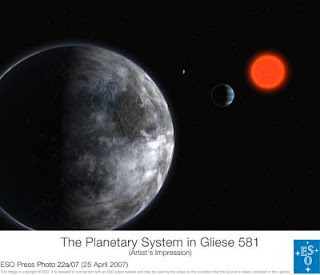 Astronomers have discovered the most Earth-like planet outside our Solar System to date, an exoplanet with a radius only 50 percent larger than the Earth and capable of having liquid water.
Astronomers have discovered the most Earth-like planet outside our Solar System to date, an exoplanet with a radius only 50 percent larger than the Earth and capable of having liquid water.
This exoplanet - as astronomers call planets around a star other than the Sun – is the smallest ever found up to now and it completes a full orbit in 13 days. It is about five times the mass of the Earth that orbits a red dwarf at a distance about 14 times less than the Earth is from the Sun.
However, as the red dwarf, Gliese 581, is smaller and colder than the Sun – and thus less luminous – scientists speculate that the planet nevertheless lies in the habitable zone, the region around a star where water could be liquid!
"We have estimated that the mean temperature of this super-Earth lies between 0 and 40 degrees Celsius, and water would thus be liquid," explains Stéphane Udry, from the Geneva Observatory (Switzerland) and lead-author of the paper reporting the result.
"Moreover, its radius should be only 1.5 times the Earth’s radius, and models predict that the planet should be either rocky – like our Earth – or covered with oceans," he adds.
Artist's impression of the system of three planets surrounding the red dwarf Gliese 581 - ESO
"Liquid water is critical to life as we know it," avows Xavier Delfosse, a member of the team from Grenoble University (France). "Because of its temperature and relative proximity, this planet will most probably be a very important target of the future space missions dedicated to the search for extra-terrestrial life. On the treasure map of the Universe, one would be tempted to mark this planet with an X."
The host star, Gliese 581, is among the 100 closest stars to us, located only 20.5 light-years away in the constellation Libra. It has a mass of only one third the mass of the Sun. Such red dwarfs are intrinsically at least 50 times fainter than the Sun and are the most common stars in our Galaxy: among the 100 closest stars to the Sun, 80 belong to this class.
"Red dwarfs are ideal targets for the search for low-mass planets where water could be liquid. Because such dwarfs emit less light, the habitable zone is much closer to them than it is around the Sun," emphasizes Xavier Bonfils, a co-worker from Lisbon University. Planets lying in this zone are then more easily detected with the radial-velocity method, the most successful in detecting exoplanets.
More information is available from the European Space Observatory’s press release.
Thursday, 26 April 2007
Astronomers find first habitable Earth-like planet
Labels:
Astronomy,
News
Posted at
3:28 pm
|
E-mail to a friend
| DiggIt! |
Del.icio.us
![]()
Subscribe to:
Post Comments (Atom)

 Dr Cathy Foley is the first female president of the Australian Institute of Physics. An industry-recognised advocate for women in Physics, Foley has been credited with starting the AIP’s Women in Physics group as well as the international group for Women in Superconductivity.
Dr Cathy Foley is the first female president of the Australian Institute of Physics. An industry-recognised advocate for women in Physics, Foley has been credited with starting the AIP’s Women in Physics group as well as the international group for Women in Superconductivity.
No comments:
Post a Comment